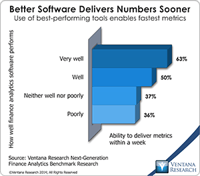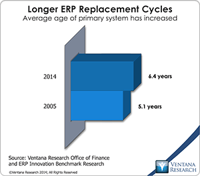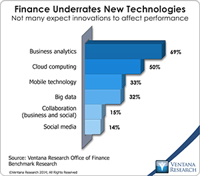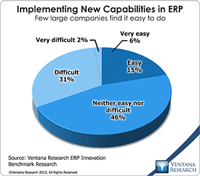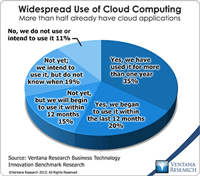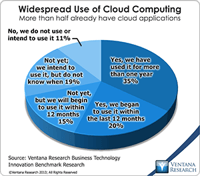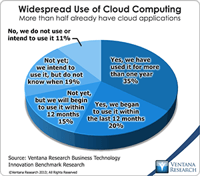Financial management software provider Intacct recently held its seventh annual user conference. In addition to a long list of enhancements in current and upcoming product releases, the company used the occasion to announce Intacct Collaborate, a capability built into its software that enables finance and accounting organizations to work together to answer questions or resolve issues while performing a process. Our benchmark research shows that collaboration ranks second in importance behind...
Read More
Topics:
Performance Management,
Salesforce.com,
ERP,
Human Capital Management,
NetSuite,
Office of Finance,
Reporting,
cloud ERP,
Analytics,
Business Analytics,
Business Collaboration,
Chatter,
Cloud Computing,
Collaboration,
Dashboards,
Business Performance Management (BPM),
Financial Performance Management (FPM),
FinancialForce,
Sales Performance Management (SPM),
Intacct
Financial management software provider Intacct recently held its fourth annual user conference. In addition to a long list of enhancements in current and upcoming product releases, the company used the occasion to announce Intacct Collaborate, a capability built into its software that enables finance and accounting organizations to work together to answer questions or resolve issues while performing a process. Our benchmark research shows that collaboration ranks second in importance behind...
Read More
Topics:
Performance Management,
Salesforce.com,
ERP,
Human Capital Management,
NetSuite,
Office of Finance,
Reporting,
cloud ERP,
Analytics,
Business Analytics,
Business Collaboration,
Chatter,
Cloud Computing,
Collaboration,
Dashboards,
Business Performance Management (BPM),
Financial Performance Management (FPM),
FinancialForce,
Sales Performance Management (SPM),
Intacct
Read More
Topics:
Microsoft,
Mobile,
SaaS,
Sales,
Salesforce.com,
ERP,
HCM,
Human Capital,
Office of Finance,
Operational Performance Management (OPM),
Dynamics AX,
Dynamics GP,
Dynamics NAV Dynamics SL,
Kenandy,
PSA,
Sage Software,
Unit4,
Analytics,
Business Analytics,
Business Collaboration,
Cloud Computing,
Collaboration,
Business Performance Management (BPM),
CFO,
Customer Performance Management (CPM),
Financial Performance Management (FPM),
FinancialForce,
HR,
Infor,
Sales Performance Management (SPM),
Supply Chain Performance Management (SCPM),
Workday,
Workforce Performance Management (WPM),
HANA,
Plex,
Professional Services Automation
Like most vendors of on-premises ERP and financial management software, in moving to the cloud Oracle has focused on developing for existing and potential customers the option of multitenant software as a service (SaaS). (I’m using the term “ERP” in its most expansive sense, to include such systems employed by all types of companies for accounting and financial management rather than only systems that are used by manufacturing and distribution companies.) Oracle’s ERP Cloud Service includes ...
Read More
Topics:
Microsoft,
Mobile,
SaaS,
Sales,
Salesforce.com,
ERP,
HCM,
Human Capital,
Office of Finance,
Operational Performance Management (OPM),
Dynamics AX,
Dynamics GP,
Dynamics NAV Dynamics SL,
Kenandy,
PSA,
Sage Software,
Unit4,
Analytics,
Cloud Computing,
Collaboration,
Business Performance Management (BPM),
CFO,
Customer Performance Management (CPM),
Financial Performance Management (FPM),
FinancialForce,
HR,
Infor,
Workday,
Workforce Performance Management (WPM),
HANA,
Plex,
Professional Services Automation
FinancialForce’s 2014 summer release incorporates improvements in mobile and collaboration features and provides enhancements to the planning dimension of its professional services automation (PSA) suite. In the last couple of releases the company emphasized expansion in the functional capabilities of its ERP suite, as I noted, focusing on human capital management and professional services automation as well as some supply chain automation capabilities.
Read More
Topics:
SaaS,
Sales,
Salesforce.com,
Social Media,
ERP,
HCM,
Human Capital,
Office of Finance,
Consulting,
distribution,
PSA,
Unit4,
Analytics,
Cloud Computing,
Business Performance Management (BPM),
Financial Performance Management (FPM),
FinancialForce,
HR,
Sales Performance Management (SPM),
Professional Services Automation,
SCM
The keynote theme at this year’s Sapphire conference in Orlando was Simple. Top executives from SAP, a software company associated with complexity, stated and restated that its future direction is to simplify all aspects of its products and the ways customers interact with them and the company itself. SAP’s longstanding and commendable aspiration to thoroughness in its software will be giving way to an emphasis on elegance in its engineering. This objective is more than admirable – SAP’s future...
Read More
Topics:
Microsoft,
Mobile,
SaaS,
Sales,
Salesforce.com,
ERP,
HCM,
Human Capital,
Office of Finance,
Operational Performance Management (OPM),
Dynamics AX,
Dynamics GP,
Dynamics NAV Dynamics SL,
Kenandy,
PSA,
Sage Software,
Unit4,
Analytics,
Business Collaboration,
Cloud Computing,
Collaboration,
Business Performance Management (BPM),
CFO,
Financial Performance Management (FPM),
FinancialForce,
HR,
Infor,
Supply Chain Performance Management (SCPM),
Workday,
HANA,
Plex,
Professional Services Automation
There’s a growing realization that the multitenant approach to the cloud isn’t the only option that companies should weigh in deciding between deploying software on-premises and in the cloud. That some people describe the multitenancy approach as “the real cloud” reflects the contentious nature of some technical debates, especially those that occur early in the evolution of a new technology. Multitenancy does have advantages that confer cost savings, and these have been important in the first...
Read More
Topics:
Microsoft,
Mobile,
SaaS,
Sales,
Salesforce.com,
ERP,
HCM,
Human Capital,
Office of Finance,
Planview,
Concur,
Dynamics AX,
Dynamics GP,
Dynamics NAV Dynamics SL,
PSA,
Sage Software,
Unit4,
Analytics,
Cloud Computing,
Business Performance Management (BPM),
CFO,
Financial Performance Management (FPM),
FinancialForce,
HR,
Infor,
Tagetik,
Workday,
Workforce Performance Management (WPM),
Plex
Information technologists are fond of predictions in which the next big thing quickly and entirely renders the existing thing so completely obsolete that only troglodytes would cling to such outmoded technology. While this vision of IT progress may satisfy the egos of technologists, it rarely reflects reality. Mainframes didn’t disappear, for example. Although they long ago lost their dominant position, many remain key parts of corporate computing infrastructures. The IT landscape is a hybrid...
Read More
Topics:
Microsoft,
SaaS,
Sales,
Salesforce.com,
ERP,
HCM,
Human Capital,
Office of Finance,
Dynamics AX,
Dynamics GP,
Dynamics NAV Dynamics SL,
PSA,
Sage Software,
Unit4,
Analytics,
Cloud Computing,
Business Performance Management (BPM),
CFO,
Financial Performance Management (FPM),
FinancialForce,
HR,
Infor,
Workday,
Plex,
Professional Services Automation
Convergence is the Microsoft Dynamics business software user group’s meeting. Dynamics’ core applications are mainly in the accounting and ERP category, descendants of products Microsoft acquired: Great Plains (now GP), Solomon (SL), Navision (NAV) and Damgaard’s Axapta (AX), to which Microsoft has added its own CRM application. It has been more than a decade since the acquisitions of Great Plains (which itself had already purchased Solomon Software), and Navision, Damgaard and the software...
Read More
Topics:
Microsoft,
SaaS,
Sales,
Salesforce.com,
ERP,
HCM,
Human Capital,
Office of Finance,
Operational Performance Management (OPM),
Consulting,
distribution,
Dynamics AX,
Dynamics GP,
Dynamics NAV Dynamics SL,
PSA,
Sage Software,
Unit4,
Analytics,
Cloud Computing,
Business Performance Management (BPM),
CFO,
Customer Performance Management (CPM),
Financial Performance Management (FPM),
FinancialForce,
HR,
Infor,
Sales Performance Management (SPM),
Workday,
Plex,
Professional Services Automation
FinancialForce recently introduced FinancialForce ERP, a family of cloud-based software designed to support a variety of customer-centric businesses such as professional services organizations or companies that specialize in business and industrial distribution. Many of these types of businesses are midsize or small (having 50 to 1,000 employees) and can benefit from the integration of FinancialForce’s accounting, professional services automation, human capital management (HCM) and supply chain...
Read More
Topics:
SaaS,
Sales,
Salesforce.com,
ERP,
HCM,
Human Capital,
Office of Finance,
Operational Performance Management (OPM),
Consulting,
distribution,
PSA,
Unit4,
Analytics,
Cloud Computing,
Business Performance Management (BPM),
Customer Performance Management (CPM),
Financial Performance Management (FPM),
FinancialForce,
HR,
Sales Performance Management (SPM),
Supply Chain Performance Management (SCPM),
Workforce Performance Management (WPM),
Professional Services Automation,
SCM



